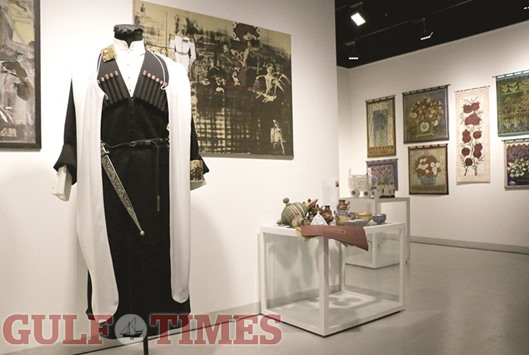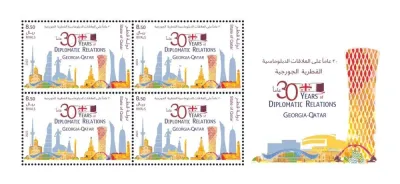From exploring the archaeological and cultural past of the nation that lay at the crossroads where Europe meets Asia, to the contemporary art and attire that flourishes as an ode to its heritage, the exhibition, which is on until January 30, gives a well-rounded perspective that delights and compels visitors to know more.
Taking a walk through the exhibition, ambassador of Georgia to Qatar, Ekaterine Meiering-Mikadze told Community, “We conceived this exhibition because we wanted to bring a piece of Georgia to Qatar. Visitors can come to this exhibition and experience the whole Georgian culture in one cut.”

Ambassador of Georgia Ekaterine Meiering-Mikadze at the exhibition.
It’s all there – archaeology to ethnography, ancient history to modern design. “We have traversed a range of elements such as wood carving, silk painting, jewellery, accessories, paintings, and have also presented beautiful Georgian costumes that are very popular among chic fashionistas,” she said, “And there’s a documentary film running, so as to explain the basic facts about Georgia and what our country is about. So, with one look, you get to have a wholesome understanding. For this, I am very grateful to Georgian Arts and Culture Centre’s (GACC) huge efforts as they managed to put together all these varied works and coordinated with artists to make it happen.”
For an embassy that is only three years old, the Georgian Embassy sure has introduced Qatar to some interesting insights into Georgian cultural heritage, like presenting the annual festival of Tbilisoba at Katara, last October, to celebrate the diverse history of Georgia’s capital Tbilisi. “When I came to Qatar three years ago, I would read everywhere – Qatar deserves the best. Hence, we are presenting the best of what Georgia has to offer,” Meiering-Mikadze said.

Some of Istoriali’s inspired jewellery pieces from the cultural heritage of Georgia.
Art Historian Maka Dvalishvili, who is the President of the GACC and the exhibition’s curator, said, “The Ambassador wanted to present as broad a range of Georgian culture as possible. While we have been working on different travelling exhibitions, we decided to blend history and contemporary art for this one.”
Istoriali, a social enterprise off-shoot of GACC, boasts of a long line of top quality Georgian Cultural Gifts that is inspired by motifs and designs of rich archaeological finds, and is also known for its traditional handmade crafts by Georgian artisans. “The jewellery pieces that you find at this exhibition are Istoriali’s reworked inspirations of ancient Georgian jewellery,” Dvalishvili said, “While the archaeological part of the exhibition has travelled to the US, Italy, and Belgium, among other countries, we have specially compiled the rest of this exhibition to present to Doha a sort of a bridge between past and present and future.”
The ethnography of Georgia is rather eclectic, the exhibition tells us. Every province in Georgia has its own images, history, culture, traditions, dress, food, music, and dance, peculiar to its people, all of which piece together the ethnographic mosaic of the country and its special charm. The most ancient type of Georgian dwelling, for instance, is darbazi, found in Eastern Georgia and made with a graded roof; the central wooden column is decorated with wood-carved symbols.
The diversity in dresses is rather pronounced. Chokha, sewn of thick fabric, tight on the waist and wide on the bottom, is common male attire across Georgia. This elegant outfit “includes a khanjali (sword), akhalukhi (shirt underneath), masrebi (bullets), and kabalakhi (a hood, separate from the robe) or nabdis kudi (a tall fur hat),” a description next to the dresses says.
As for the women’s attire, it comprises a shirt (perangi), long trousers (sheidishi), long dress with a breast plate (gulispiri), and a long fabric belt (sartkeli). What stand out most perhaps among the varied Georgian national costumes is the colourful female and male clothing from Khevsureti, which are usually decorated with exquisite embroidery. Fortunately, these pieces are on display for us to get a real feel of the heritage.
Traditional Georgian crafts, we are told, revel in ceramics, earthenware and woodwork. Woodwork, for instance, would be widely used in folk architecture and objects of everyday life such as traditional furniture like armchairs, bedsteads, chests, cradles, musical instruments and tableware.
On display are some cool creations by Georgian woodcarvers like Zura Misriashvili and Zaza Gatenashvili. While the former creates vases of various shapes and sizes, bowls, tables and backgammon boards, the latter works with traditional Georgian ornaments and shapes.
Georgia has always been famed for its textiles as for its crafts. The exhibition gives us a glimpse into the “arts made by La Maison Bleue.” These pieces are modern paintings but are made using the ancient technique of Batik. A Javanese technique of wax-resist dyeing applied to whole cloth, or cloth made using this technique, Batik painting made its entry in Georgia in the 1970s.
Georgian artists currently use two methods; the traditional one using hot wax and the modern one, the cold batik, using a wax pen, mostly for scarves and small-sized accessories.
As for the archaeological finds corner – helped all the more by the 3D visuals splattered across the walls – the information put out attests to the fact that weaving and dyeing was well-developed in Georgia.
“The high qualities of dyes that are preserved even today speak of the artistic taste and professional skill of their engravers,” a note says, further adding about the country’s expertise with metal work, “Owing to its rich natural resources and geographical location, Georgia developed metallurgical traditions that go back to the Early Bronze Age, the 4th to 3rd BC.”
In the contemporary section, the pleasant burst of colours and an eye-catching variety of art and artefacts are hard to not fall for. Samoseli Pirveli, which means first garment, specialises in traditional Georgian clothes that are made in line with new contemporary requirements, and their take on Georgian male and female attire is utterly likeable. Then there are also some fascinating works of art, such as pieces from pottery artist George (Gigisha) Pachkoria.
Meiering-Mikadze said, “The relationship between two countries is like a big puzzle. To solve this puzzle, you have to work with all the pieces like economic, political, multilateral, bilateral, sport and cultural co-operation. In sport, where Qatar is becoming the global hub for top sporting events, we have lots of Georgians participating here. So, even with culture, we know we must showcase our best. We may not have oil and gas, but we certainly have a treasure trove of culture to offer. We emphasise on that and have been co-operating with different cultural institutions in Qatar like Ministry of Culture, Katara, Qatar Museums, and others.”



